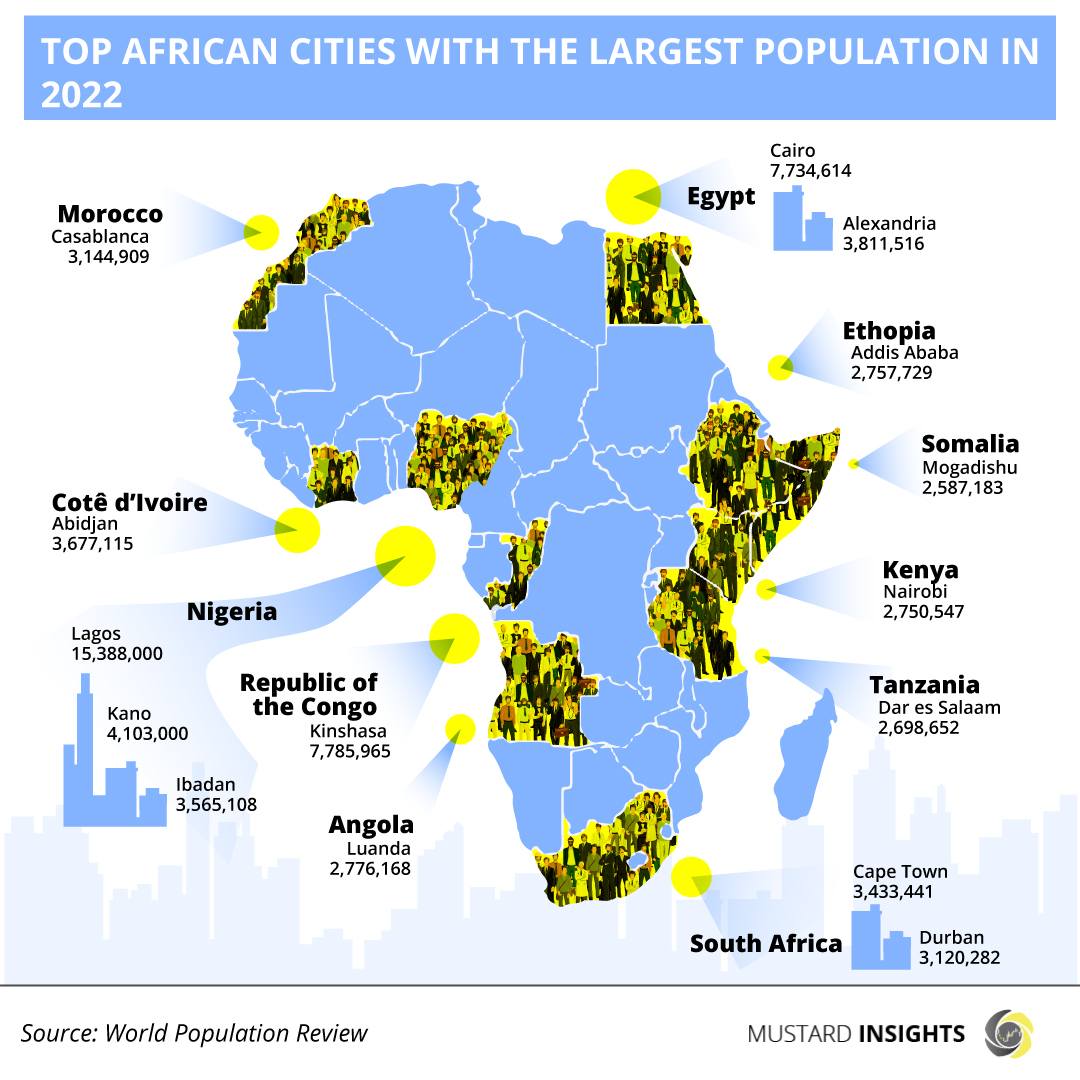Exploring Africa's most largest cities, and how they attained their standing.

It is not uncommon for countries to have major agglomeration centers. The big city were people from other parts of the country grow up thinking of moving to; the city where dreams are made into reality; the “mega-city”. The United States of America has New York and California; the United Kingdom has London; Nigeria has Lagos. For better or worse, people tend to congregate in these cities, creating these areas of high population density. It is instructional to understand how these cities came into being.
A theme of most of these cities is that they tend to be coastal. This is to be expected: historically, most international movement of people and goods happened by sea. The shipyards and docks will then create a small gathering of people who serviced the sea trade: merchant houses, inns/hotels, repairmen – they would all live within distance of the harbour where the ship docked.
Think the cities of Rotterdam in the Netherlands, Hamburg in Germany, or London in the United Kingdom. These cities have been significant for centuries because they were just were the ships docked. The port at Hamburg has been operational since the 9th century, and Rotterdam since the 13th. London, on the other hand, has been an important trading port since as far back as the 3rd century.
Relate this phenomenon to Africa, and you first notice Cairo at the mouth of the Nile and Alexandria on the Mediterranean. Cairo’s location at the Nile Delta ensured fertile plains and the city served as a junction for trade from countries along the Nile to the Levant. Alexandria, on the East Mediterranean, was an important centre for both the Egyptian, Greek, and Roman empires. Its accessibility once led to it being, for a brief period, that largest city in the Western world. Both cities are still Egypt and North Africa’s most populous cities today.
The cities of Abidjan, Lagos, and Casablanca also serve as major port cities for Côte d'Ivoire, Nigeria, and Morocco respectively. Casablanca has a much longer history, being used as a port by the Romans, with Lagos servicing the ancient Benin Empire. Casablanca and Lagos still have two of the busiest seaports in Africa, and both cities along with Abidjan serving as the major economic and financial centres of their countries, along with being major centres of culture and tradition. Casablanca is a growing centre of tourism, and one of the Arab world’s largest cities.
Lagos, in particular, might be Africa’s most influential city in terms of tourism, entertainment, technology, art, and fashion. It is a tech start-up hub, the centre of Nigeria’s giant movie and music industry, and the birthplace of the uber-popular Afrobeat music genre. Most population estimates might be incorrect, with the World Population Review’s figure of slightly above 15 million said to be well below the actual number, which may rise as high as 20 million.
The Democratic Republic of Congo’s Kinshasa follows Cairo in that while it is not on the ocean coast, it lies along the path of a great river on its journey to the sea, the Congo River in this case. Kinshasa was once Sub-Saharan Africa’s largest city by population, and is now one of the world’s fastest growing megacities. It is the largest Fracophone urban area in the world, surpassing Paris in France, and is Africa’s third-largest metropolitan area after Lagos and Cairo.
Angola’s Luanda and South Africa’s Cape Town and Durban are all major population centres which follow the trend of being by the ocean coast a la Lagos and Casablanca. Luanda is one of the oldest shipping ports in Africa, and for a while was a major world port, largely due to the slave trade between the Portuguese Colonies of Angola and Brazil. By the time of Angola’s independence in 1975, Luanda was already a major city due to the dominant Portuguese influence and residents from all over the country moved there. While it is hard to get accurate figures, it is estimated that as much as 25-35% of Angola’s entire population live in Luanda.
Cape Town has been a historically significant region for both native South Africans and Europeans for centuries. It was a major stopover on the sea route to India from Europe as far back as the 17th century. It is presently one of South Africa’s three capitals, along with Pretoria and Bloemfontein. It’s natural harbour and great physical beauty have led to a thriving tourism industry, and it is only matched in population by Durban, another tourist city which happens to be the largest city on Africa’s Indian Ocean coast.
Other major cities along Africa’s Indian Coast are Tanzania’s Dar es Salaam and Somalia’s Mogadishu. Dar Es Salaam is prominent in East Africa for its seaport being the preferred trade route of landlocked nations such as Rwanda, Zambia, and parts of the massive DR Congo which are too far from the Atlantic sea trade. It was a colonial centre during the German occupation of the country, and is one of East Africa’s fastest-growing cities.
Somalia’s Mogadishu, on the other hand, has long been a prominent city, one of Africa’s oldest. It was the capital of the ancient Sultanate of Mogadishu as far back as the 9th century, when it controlled the trade of gold from Africa’s east coast to India and maybe as far as China. It was a city of great wealth in the 10th to 15th century, signs of which can still be seen. Presently, it is a commercial and business center and its seaport is one of the oldest in East Africa, along with being the largest.
Like Mogadishu, Ethiopia’s Addis Ababa has a long history as the home of the country’s emperors and remains the capital and largest city in Ethiopia. It is a great centre of arts and culture, and has one of the fastest growing economies in the world, suggesting a future population boom. The other major East African city is Nairobi, which despite not being a trade hub, is a thriving centre of business and tourism. The city is also one of Africa’s major tech hubs along with Cairo and Lagos, which suggests an influx of younger citizens from all over the country.
Takeaway
A major theme of all the major population centres is trade. People will always congregate in cities were trade happens, and since a lot of the world trade has often happened by sea, coastal cities have bloomed. Trade centralization can be bad for the rest of the country, as all the talent and resources get drawn to one spot, as has happened in Nigeria and Angola with Lagos and Luanda respectively.
Countries can combat this by developing other cities, and some ways to go about this might be the building of international airports and extensive road networks. Decongesting the major cities or creating other agglomeration centres will spread development around the country and improve living conditions while driving economic growth by creating multiple centres of commerce and industry around the country.
Zambia’s Top Export and Import Trading Partners in 2021
Thoughts?
We won't share your email address. All fields are required.
